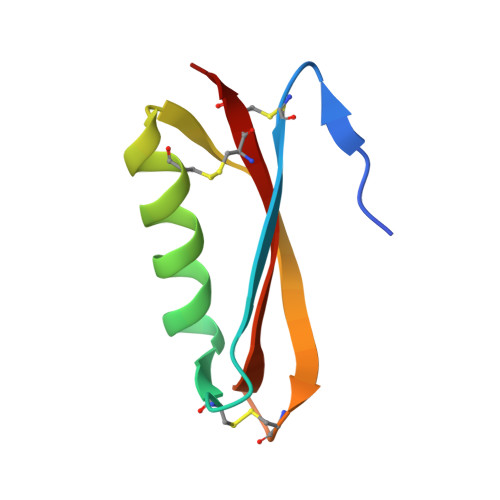Structural Studies of the Alzheimer's Amyloid Precursor Protein Copper-binding Domain Reveal How it Binds Copper Ions
Kong, G.K., Adams, J.J., Harris, H.H., Boas, J.F., Curtain, C.C., Galatis, D., Masters, C.L., Barnham, K.J., McKinstry, W.J., Cappai, R., Parker, M.W.(2007) J Mol Biol 367: 148-161
- PubMed: 17239395
- DOI: https://doi.org/10.1016/j.jmb.2006.12.041
- Primary Citation of Related Structures:
2FJZ, 2FK1, 2FK2, 2FK3, 2FKL - PubMed Abstract:
Alzheimer's disease (AD) is the major cause of dementia. Amyloid beta peptide (Abeta), generated by proteolytic cleavage of the amyloid precursor protein (APP), is central to AD pathogenesis. APP can function as a metalloprotein and modulate copper (Cu) transport, presumably via its extracellular Cu-binding domain (CuBD). Cu binding to the CuBD reduces Abeta levels, suggesting that a Cu mimetic may have therapeutic potential. We describe here the atomic structures of apo CuBD from three crystal forms and found they have identical Cu-binding sites despite the different crystal lattices. The structure of Cu(2+)-bound CuBD reveals that the metal ligands are His147, His151, Tyr168 and two water molecules, which are arranged in a square pyramidal geometry. The site resembles a Type 2 non-blue Cu center and is supported by electron paramagnetic resonance and extended X-ray absorption fine structure studies. A previous study suggested that Met170 might be a ligand but we suggest that this residue plays a critical role as an electron donor in CuBDs ability to reduce Cu ions. The structure of Cu(+)-bound CuBD is almost identical to the Cu(2+)-bound structure except for the loss of one of the water ligands. The geometry of the site is unfavorable for Cu(+), thus providing a mechanism by which CuBD could readily transfer Cu ions to other proteins.
Organizational Affiliation:
Biota Structural Biology Laboratory, St. Vincent's Institute, 9 Princes Street, Fitzroy, Victoria 3065, Australia.














